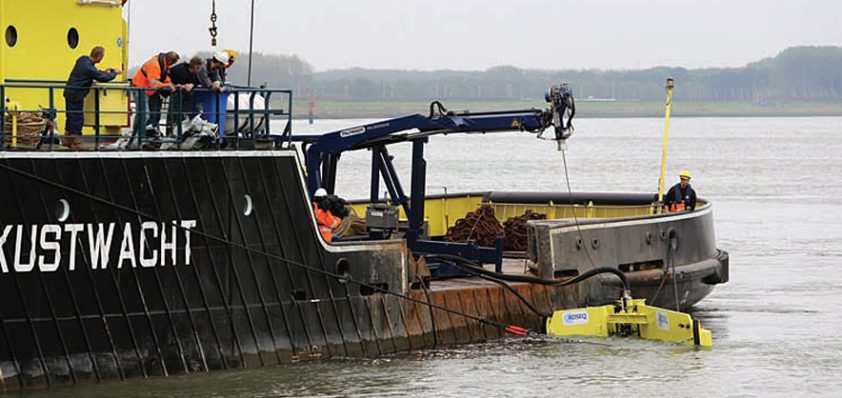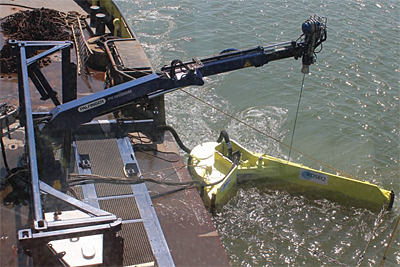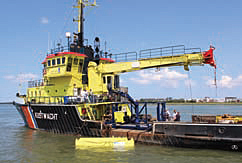
Koseq BV
A clean sweep
As the transportation of oil increased in the 1960s and 70s, so too did the risk of major incidents where vast amounts of oil polluted the waters and coasts, causing damage to the environment, its inhabitants and operational capabilities across the globe.
Due to the huge costs and efforts need to clean up oil, beaches and surrounding areas following a spill, the Dutch Ministry of Transport, Public Works and Water Management (Rijkswaterstaat) called for the development of a tool for the swift recovery of oil. Utilising its 40 years of expertise, Koseq BV took on the challenge and came up with a solution for the removal and recovery of large  quantities of oil from the water surface; known as the Rigid Sweeping Arm, Koseq’s product generated huge amounts of interest from the oil industry when it was launched and has since been used during some of the most recent major oil spill disasters.
quantities of oil from the water surface; known as the Rigid Sweeping Arm, Koseq’s product generated huge amounts of interest from the oil industry when it was launched and has since been used during some of the most recent major oil spill disasters.
“In the 1970’s we started the development and production of the sweeping arm under the name of Doseq. Most systems were sold in the Netherlands, at a time when there wasn’t much effort in export. That changed after the Prestige oil spill, near Spain in 2002; Spain had no means to recover oil offshore and hired 12 vessels from all over Europe with different types of oil spill equipment. Two vessels recovered together over 80 per cent of the total amount: the Arca and the Rijndelta, which were both equipped with our sweeping arms. Since then we have received enquiries from all over the world, which led to our decision to start Koseq,” begins Tom Achterberg, engineering manager at Koseq BV.
Mainly used by governments or government related organisations that handle pollution issues, the Koseq sweeping arm was created to meet the aims of Rijkswaterstaat and TNO (Dutch Organization for Applied Scientific Research) for a product that mechanically recovers large amounts of spilled oil in a short time frame, operates effectively in rough seas and harsh weather conditions and offers complete reliability. Successfully meeting these requirements, the rigid sweeping arm is pulled beside a vessel and consists of two pontoons, which gives the arm its floating capacity and stability, even in rough seas. In addition, the product has a bridge piece to guide the oil to the oil collection chamber within it, the height of which is hydraulically adjustable to handle any thickness of oil layer.
Once collected, the oil/water mixture is pumped onboard through an oil transfer pump, which uses an impeller that combines the properties of a screw pump with those of a centrifugal pump. This integration ensures the pump is highly suitable for high viscous oils, while remaining less sensitive to debris. On board the vessel, the oil/water mixture is separated before the water is pumped overboard; this recovery continues until the tanks onboard are completely filled with oil.
On top of its rigid sweeping arm concept, the company also manufactured the compact sweeping arm and the v shaped victory oil sweeper, the latter of which is a rigid sweeping arm system to  meet the needs of clients such as coast guards and ship owners that own smaller vessels. Consisting of a smaller arm when in folded mode, the victory oil sweeper gains length when unfolded, which thus makes the recovery of oil spills from rivers, estuaries, drilling rigs and offshore installations a possibility. Other advantages of this new product include an adjustable angle, which allows for choice between a large sweeping area or enhanced sweeping speed at a lower angle, and extra pumping capacity thanks to a second pump.
meet the needs of clients such as coast guards and ship owners that own smaller vessels. Consisting of a smaller arm when in folded mode, the victory oil sweeper gains length when unfolded, which thus makes the recovery of oil spills from rivers, estuaries, drilling rigs and offshore installations a possibility. Other advantages of this new product include an adjustable angle, which allows for choice between a large sweeping area or enhanced sweeping speed at a lower angle, and extra pumping capacity thanks to a second pump.
Committed to the ongoing improvement of its equipment and innovative developments, the company opened a new office in Ridderkerk, the Netherlands in February 2014 and expanded its R&D department; a move that has resulted in the development of new products, as Tom notes: “The Compact 502 is now finished; it is based on a compact five sweeping arm, which is a smaller version of the big sweeping arm. Although our sweeping arm system works perfectly, it requires some adaptation from the vessel that it is installed on. The Compact 502 arm is mounted within a 20 feet ISO container size frame, together with a crane, diesel driven power pack and an operator unit. This is a complete unit, easy to transport and install, with everything you need to recover oil; the only item that has to be found on board the vessel is storage for the recovered oil.”
Since it introduced and demonstrated the Compact 502 to the market in Vlaardingen on 14th October 2014, the company is now focusing on taking advantage of opportunities within the oil spill market, as Tom concludes: “The oil spill market is growing and environmental issues are becoming increasingly more important as people become aware of the dangers of oil pollution. To meet this growth, we have a unique method for the recovery of oil, which has proven to be the most effective in real oil spills. Besides that, we have a skilled R&D team that is now working on new products. Although we have already established great success with our systems in Europe, our next aim is to expand our presence on a global scale.”
Koseq BV
Services: Developer and manufacturer of oil spill recovery equipment